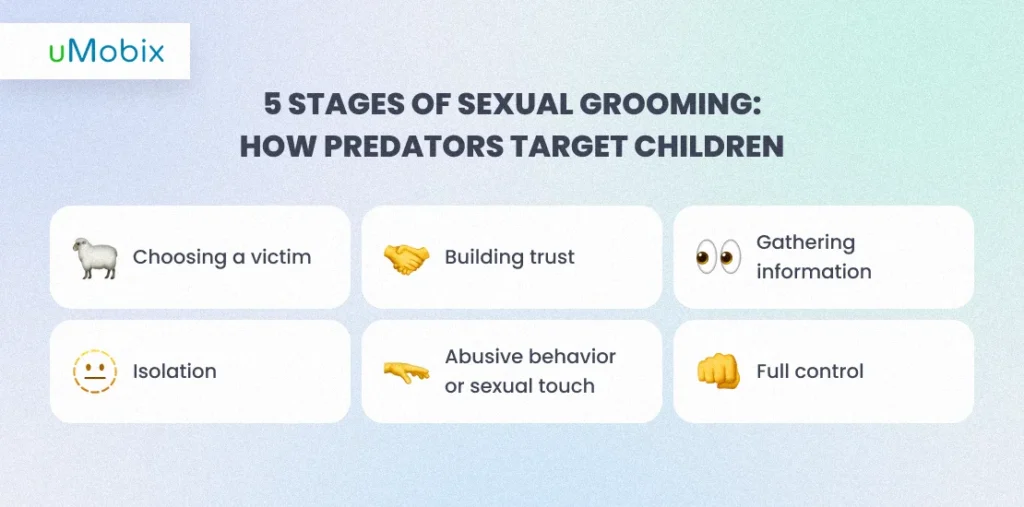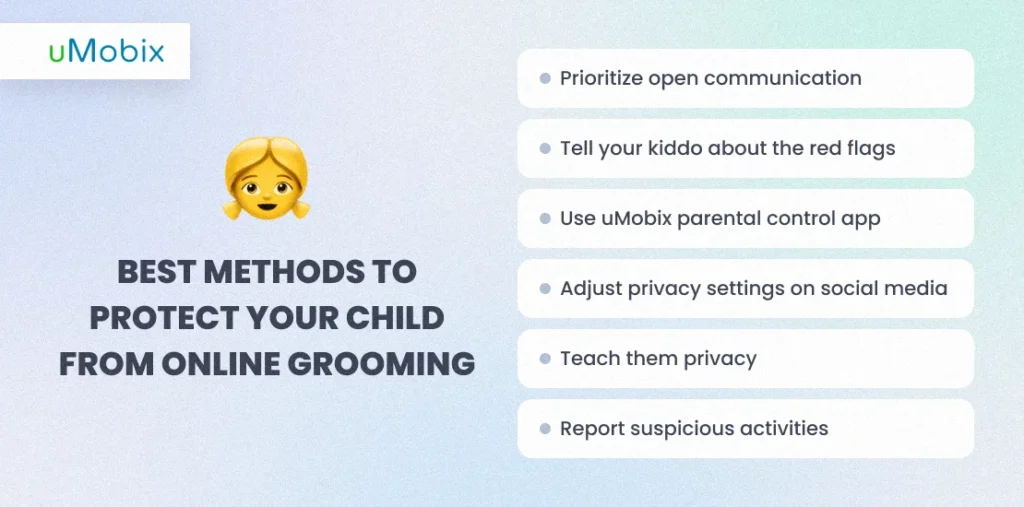Grooming is one of the most devastating crimes affecting children globally, with girls being three times more likely to be groomed than boys. In 2020 alone, 18,000 child trafficking victims were identified across 166 countries. In 2023, the National Center for Missing & Exploited Children (NCMEC) reported 28,800 missing children, with 1 in 6 likely being victims of child sex trafficking.
Although the detailed statistics for 2024 are not yet available, predators continue to exploit children’s innocence, subjecting them to unimaginable psychological and physical trauma. Just reading this is alarming – imagine the terror experienced by a child who has lived through it. Therefore, recognizing the signs of grooming a child is crucial in preventing these heartbreaking situations.
So, whether you are curious about what grooming is, especially sexual grooming, want to recognize grooming behaviors, or you’ve already noticed signs of grooming and are unsure how to proceed or protect your child, we’re here to offer the guidance and support you need to keep your children and teens safe. Keep reading this article to find the answers to all the burning questions.
What Is Grooming?
A short online grooming definition is sexual abuse. It can happen both online and in person, starting with friendly behavior to gain the victim’s trust. Grooming can be done in a short or long period of time, ranging from weeks to years. Sexual abusers may also form bonds with the young person’s family or friends in order to make them appear trustworthy or authoritative. It’s all part of a calculated plan to exploit the younger person sexually or emotionally once they’ve been involved.
What are the signs of online grooming? At first, there are subtle signs of grooming. The type of behavior an abuser initially puts up appears to be harmless. They might, for example, express their gratitude with words or a token. However, these grooming signs progress to include physical contact like hand-holding, extended hugs, kisses on the cheek, sexual innuendos, and secret-sharing.
In-Person Grooming
In-person grooming is a process where an adult with malicious intentions builds a strong emotional connection with a child to manipulate, exploit, or abuse them. Frequently, a groomer does its best to increase the target’s trust and, more importantly, tries to build strong relations with the victim’s relatives or friends through special attention or gifts. Recognizing child grooming signs early and noticing any unusual behavior in your child can help protect them from potential harm.
Online Grooming
Kids frequently browse the internet to watch entertaining videos, listen to famous bloggers, send text messages through social media platforms or dating apps, or simply play online games. They can easily meet new people there and start conversations with them. Unfortunately, although getting new acquaintances online is easy, it is not so when you want to detect whether someone is trying to trick or persuade you to do things. And it becomes even more difficult when the victim is a kid.
There are some signs of groomer that can be noticed. The most frequent behaviors are as follows:
- they try to have a sexual conversation with someone
- groomers share sexual thoughts, messages, and intentions
- try to convince someone to share sexual photos or videos
- they force or scare someone into selling drugs, hurting others, or doing something illegal
- blackmail someone into giving money or sharing sensitive data (home address, cell phone number, credit card details, etc.)
- meet in person in order to engage in sexual activities or exploit the victim further
What Is Online Grooming?
Online grooming is one of the most frequent types of grooming nowadays. Groomers, as a rule, hide behind the anonymity of the internet to manipulate children, often pretending to be someone else or using false identities to gain trust. Typically, they communicate with their victims through chat rooms, online games, or messaging apps as part of their virtual grooming tactics.
Social Media Grooming
In comparison with online grooming, social media grooming, as its name suggests, occurs primarily on social media platforms such as Instagram, Facebook, Snapchat, or TikTok. A groomer uses different tactics to manipulate their victim: write comments under their posts, respond to stories, write private messages, etc – common signs of sexual grooming.
Understand the Stages of Sexual Grooming
Well, what are the stages of grooming you should know about? Read below to find out how a victim is chosen and what actions a pedophile can take.

- Choosing a victim: A groomer spends some time choosing their victim, the person who, as they think, would be the most vulnerable. This could be a child without adult supervision or one who frequently shares sadfishing posts or emotional content online, seeking support. This also applies to signs of grooming by a family member, who may be in a position of trust and access, making it harder to detect.
- Building trust: Once their victims are found, groomers start communication with them in a friendly and polite manner, trying to build trust and create a sense of emotional connection. When trust is built, they will give their victim lots of compliments and tell them how much they want to hang out with them. They might give a kid gifts and pay you a lot of attention to their feelings and daily routines.
- Gathering information. They may inquire if someone has access to their device to identify potential obstacles and manipulate your child more effectively – one of the most typical grooming signs.
- Isolation: They will do their best to isolate your kid from family and friends. A groomer will provide arguments that no one but they will always understand and support a child. The goal? They want the kiddo to become dependent on having them in their life.
- Abusive behavior or sexual touch: After isolating the child from their friends, a groomer may start to touch the child inappropriately, like with hugs or playful wrestling. They might introduce them to alcohol or drugs, show them porn, or ask them to take and share sexual photos or videos.
- Full control: At this stage, a groomer tries to manipulate the kid and their thoughts and demand sexual favors or blackmail them. They can use physical violence to get what they want.
Recognizing the Signs of Grooming
Building relationships with people online or in other parts of your life is normal. However, grooming happens when someone takes advantage of those relationships to trick, force, or manipulate someone into doing something sexual or illegal.
Here are the main signs of grooming you as a parent must pay attention to:
- Secretive behavior: It is one of the most common child grooming signs. A groomer shows your kid’s importance to create a fake sense of importance and trust. If you ask your kid about their “secret” friend, they may refuse to tell you any details.
- Sending 18+ content: It is on the list of signs of grooming a teenager. They may start by asking whether your kid has already kissed anyone or had other physical contact. In the long run, they may exchange nudes. Parental control apps will help keep an eye on all communications.
- Gifts: Everyone likes gifts, especially kids, and groomers know that. They make gifts especially to create a sense of obligation and affection so that a kid won’t be able to refuse when they ask them to send explicit content, one of the most common signs of grooming a teenager. So, if you have noticed your kid gets gifts from their new online “friend”, do not ignore it.
- Isolation: They do their best to isolate your kid from others so that they only communicate with them, which is one of the grooming signs. You will notice your kid has become isolated and refuses to spend time with family or peers.
What Can You Do When You See Signs of Grooming?
Here are five potent ways to deal with grooming and help your child overcome it:
- It’s totally normal to feel overwhelmed when you realize your child’s been groomed. However, it would be best if you remained calm. If you lose your cool and confront your child, they may become adamant about not talking about it.
- Block access to pornographic websites using internet filters. As part of the sexualization process, groomers frequently share pornographic websites with their targets.
- Discuss improper behavior and words from other adults with your child, and give them the confidence to come to you if this occurs.
- Teach children to inform you if they are offered or given presents by anyone, regardless of who it is. Tell them they have to reduce contact with the individual, especially if they are making your kid uncomfortable.
- Check your kid’s cell phone regularly. If you notice signs of grooming a child, report the situation to authorities immediately.
- Consider taking them to a mental health professional for support.
How to Protect Your Child from Online Grooming
Well, all the above-mentioned information can scare you. So, what can you as a parent do to protect your kid from online grooming? How to detect a person who is grooming your kid?

Use uMobix Parental Control App
Use a uMobix cell phone tracking app to monitor your child’s smartphone activities. The app will easily help you to detect signs of grooming. The most popular features provide you access to all the call logs, SMS, and chats, even the deleted ones. Tracked data will be delivered to your user space in the form of screenshots taken in real time.

It will also help you spy on and read all communications over Instagram, WhatsApp, Facebook, and other social media platforms. What is more important is that you will get full access to their FB and Instagram accounts so that you will be able not only to read their sent, received, or deleted messages but also to respond to them if needed. It will help you detect one of the grooming signs mentioned above.
Say you wish to check your kid’s photos and videos regularly. In that case, uMobix is the best fit. It will retrieve all media files saved on the device you want to monitor. Audio and video streaming features will help you stay wary of every step your kid does, with whom they communicate, and who is close to them when not online.
Other Tips to Staying Safe from Online Grooming
Here are some of the important steps you can take to protect your child from online grooming.
- Take their smartphone and adjust their privacy settings in their social media apps. Make their account private so that only chosen people can get in touch with them.
- Teach them privacy. Explain what content can be shared publicly and which one cannot. Tell them that they should never share sensitive data like their home address, school, phone number, or credit card details online.
- Red flags. Explain to them the red flags they should pay attention to. Tell them about the examples of online grooming. So, if they notice any suspicious behavior, they should nip it and ask you for advice.
- Talk regularly. You must be your kid’s best friend. Never shout or criticize them. Try always to support them so that they can always tell you their thoughts and fears.
- Report suspicious activities. Tell your kiddo that if they notice any suspicious activity reminding those of signs of online grooming, they must immediately report their behavior to the platform or authorities. Teach them how to do it.
Final Thoughts
Protecting your child from grooming starts with awareness and open communication. Pay attention to red flags like secretive behavior, online interactions with strangers, or inappropriate content. Using tools like uMobix can help you detect signs of being groomed early and keep your child safe from online predators. A parental control app will let you stay aware of your child’s secret communications and suspicious acquaintances.
FAQ
Some of the most typical traits of child sexual abuse predators include a very high level of physical interaction with youngsters like tickling, wrestling, etc. They also prefer to be with youngsters over grownups and are willing to help with anything that has to do with kids. Lastly, they almost always have a small number of friends to vouch for them.
Sexual grooming of a woman by a man is a pre-planning procedure in which a perpetrator (the man in this case) progressively gains the trust of a person (the woman) in order to sexually abuse them, pressure them into agreeing to the abuse and limit the danger of being caught. Typically, the victim is a youngster, an adolescent, or a vulnerable adult.
If you suspect your child is being groomed by a pedophile or adult predator, you should take urgent measures to eradicate or at the very least minimize your child's contact with the individual. You should also inquire about your child's relationship with them and establish an open line of communication with them, providing a secure space where they may express themselves without fear of being judged. Keep in mind that the predator might have convinced your child that you are untrustworthy.
Internal fragility, violence, and a general suspicion of those around them are common characteristics of malignant narcissism. They're notorious for being deceptive, and their lack of empathy for others means they'll go to any length to achieve what they want.
Abusers utilize the internet to sexually exploit youngsters, and the phrase "online grooming" is used to characterize their methods. It can happen fast or gradually, but it's essentially a process of combining fear and shame to keep a child silent while manipulating trust to modify expectations of what constitutes safe behavior. They'll usually respond with a narrative of their own, which may or may not be true, or they'll attempt to empathize with you by telling you that they understand and that you can always come to them for anything.





